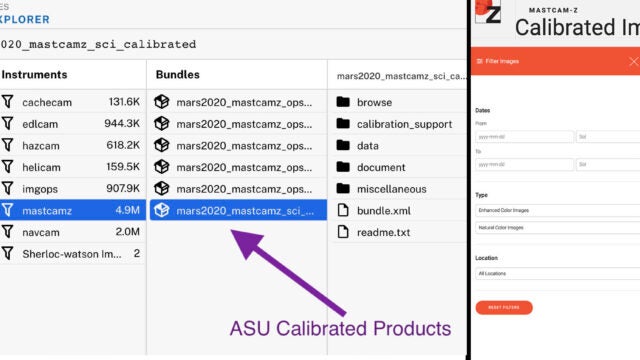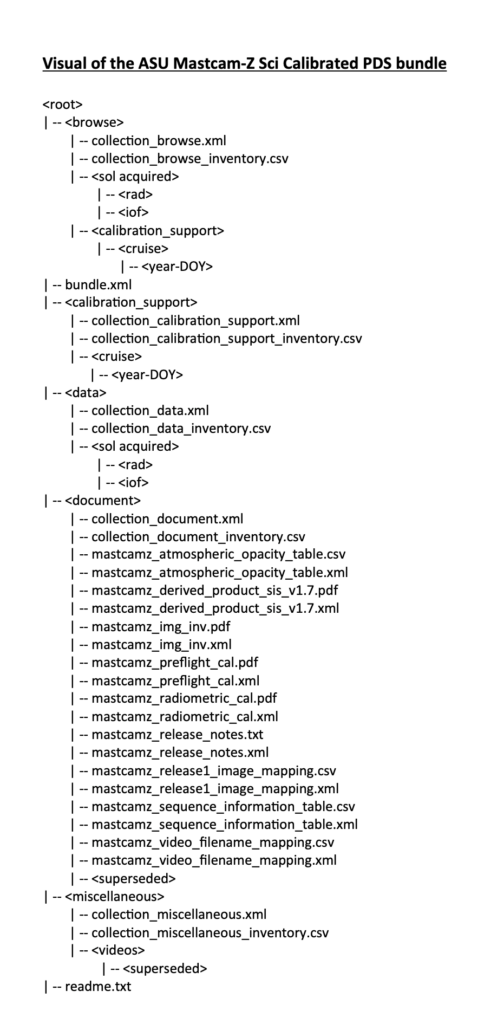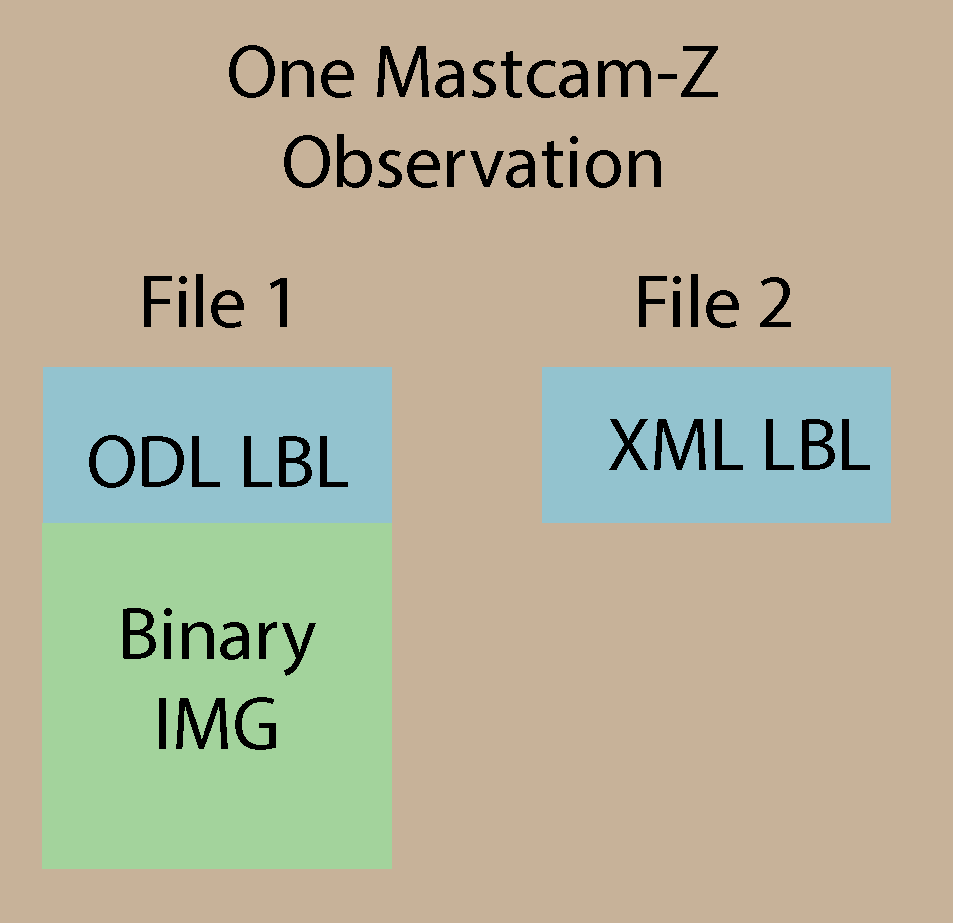
2024-12-08
Mastcam-Z Data for All!
Contributed by Alyssa Bailey, Ernest Cisneros, Sydney Larriva, and Jim Bell and last updated on 8 December 2024
Attention! Attention!
Are you looking for the best calibrated Mastcam-Z images? Well look no further!
What is a calibrated image and why should we use them?
“RAD” or radiance calibrated images create better mosaics that are not only more seamless but also more scientifically useful for tactical rover planning and scientific analysis. The RAD calibration process removes the effects of the camera filters and optics (for example, dust blemishes and vignetting) and electronics (for example, dark current and frame transfer smear) to convert images into a true representation of the brightness of the observed scene in physical units like Watts.
MANY more technical details about RAD calibration can be found in the peer-reviewed journal article by Mastcam-Z team member Alex Hayes and colleagues, available free online here. For example, RAD calibration is performed on all images except for our zero-second exposure “shutter frames,” which are occasionally acquired and used in the calibration of their associated non-zero-second exposure images when high calibration fidelity is required. Otherwise, the shutter frames can be simulated using pre-flight calibration data if they have no accompanying zero-second exposures.
“IOF” or radiance factor calibrated images are used for scientific analysis of our 11-color filter data sets (Mastcam-Z’s color filters are described in detail in our “Colors of Mars” blog entry). IOF means “I over F”, where “I” is the radiance or RAD calibrated image described above, and “F” is the radiance of sunlight beaming down onto the surface. This ratio yields the approximate reflectance of the materials in the scene. The calibration process converts a RAD image to an IOF image using an analysis of the calibrated radiance (RAD) images of the Mastcam-Z calibration targets, which are described in detail in our “Calibration Targets” blog entry. Almost all RAD calibrated images get converted to IOF, excluding solar filter (L7/R7), zero-second exposure images (shutter frames), and post-sunset/pre-sunrise observations. A great Planetary Society article about our calibration targets can be found at this link, and MANY more technical details about IOF calibration can be found in the peer-reviewed journal article by Mastcam-Z team member Kjartan Kinch and colleagues, available free online here.
In addition to RAD and IOF images, other miscellaneous calibrated images are also created, like radiance calibrated video products of Ingenuity taking flight on Mars!
Where can I find these images?
You have two options, depending on the data format you’re seeking: First, Mastcam-Z calibrated images are publicly available as 8-bit color-scaled natural and enhanced color single-image PNG files here on the Mastcam-Z Public Web site’s “Calibrated Images” archive. These images are the calibrated counterparts to the raw PNG-format images being released every day on NASA’s Mars Perseverance Raw Images public web site.
However, if you want to work with the original raw 16-bit or calibrated floating-point images, you should use the second option: those higher-fidelity “science-grade” images are publicly available through the Planetary Data System (PDS). The PDS is a NASA archive that allows anyone in the world to access, download, and enjoy our calibrated data products now and hopefully for countless years to come. The rest of this article focuses on describing how to find that PDS archive, and how it is organized.
Our Mastcam-Z images are specifically archived in one part of the PDS, called the Cartography and Imaging Sciences Node! PDS releases of Mastcam-Z images calibrated at Arizona State University go out every 4 months. New releases cover a specific sol range for each release. So far, the ASU Mastcam-Z team has completed eleven PDS releases covering sols 0-1259 with a data volume of about 2.7 Terabytes!! The next PDS release will cover sols 1260 – 1379 and be available on April 3rd, 2025… so mark your calendars!
In addition to RAD and IOF images, you can find miscellaneous products like radiance calibrated video products of Ingenuity taking flight on Mars or watching one of Mars’s moons, Phobos, transit the Sun!
To find the PDS-archived Mars 2020 Perseverance image data from all of the cameras on the rover, navigate to https://pds-imaging.jpl.nasa.gov/beta/archive-explorer?mission=mars_2020. You will see a menu like this, then click on mastcamz and then the mars2020_mastcamz_sci_calibrated folder, which the PDS calls a “bundle”:

Another way to get to this PDS bundle is via its a Digital Object Identifier (DOI), a dedicated web address that can take users right where they need to go. The DOI for the Mastcam-Z PDS bundle is 10.17189/q3ts-c749, which can be accessed online via this link.
What is a PDS bundle? A bundle is the box our products are contained in at the PDS. Within the bundle are smaller boxes called “collections” which separate different types of products:

The Mars2020 Perseverance instrument data are archived in a format called “PDS4”, which is described in detail by the documents provided online at this link. All PDS4 archived image products come with an external XML (eXtensible Markup Language) file or “external file label” that contains ancillary information about the image. These XML labels have the metadata extrapolated and easily viewable for all interested parties. The bundle contains an xml file called bundle.xml with pointers and descriptions about the bundle, and each collection has an inventory list called collection_<insert collection here>.csv and a corresponding xml label with details about each collection, including the file count:

The browse collection has a quickly viewable PNG-format image product associated with each image in the data collection.
The bundle.xml file is a PDS4 required xml file with the full contents of the bundle.
The calibration_support collection has raw cruise data used for calibration and classification of
the Mastcam-Z cameras. These products are archived raw (EDR) and have not been RAD or IOF
calibrated.
In addition, the data collection has radiance (RAD) and radiance factor (IOF) calibrated images saved in binary image format with a “.IMG” file extension. These .IMG files come with an embedded text-readable header or file label (called an “Object Description Language” label or an “ODL” label) which provides the same important information about the image as the external XML label file:

Archiving the label information in both these ways (internal to the file and external to the file) allows both older and newer PDS image viewing software to work with the images.
The document collection has associated documentation for the Mastcam-Z calibrated images, such as the instrument papers which describe the cameras and calibration in greater detail, a software interface specification (SIS) document designed to help users understand the archived products, release notes that get updated with each release, and more!
The miscellaneous collection is for other things made using Mastcam-Z calibrated images, like 10 amazing videos of Ingenuity helicopter flying on Mars!
Finally, the readme.txt file serves as a guide to help users in their navigation of the Mars 2020
mastcamz_sci_calibrated Bundle and assists in the understanding of file naming conventions.
File formats found in the archive include:
PDF/A – documents, like instrument papers, SISs etc. in Adobe’s Portable Document Format
CSV – documents and collection inventories in Comma-Separated Values
TXT – documents, release notes etc. as plain ASCII text files
PNG – browse products in Portable Network Graphics format
MP4 – archived Mastcam-Z videos
IMG – full resolution binary data image products with an embedded ODL label
XML – independent PDS4 compliant file with label information in eXtensible Markup Language format
Want More Details?
For more information on the Mastcam-Z images archived in the PDS, see the Mastcam-Z release notes available in the documents collection! These will describe new things for each release, any image issues like mispointing or saturation, in addition to other things that users might want to be aware of
MANY more details can be found in the Mastcam-Z Derived Data Product Software Interface Specifications document, or “SIS”, archived on the NASA/PDS at this link. In addition, the Mars 2020 Camera SIS document provides complete details on all the keywords in the label or header of each raw and calibrated image file.
And to find the mission bundle and data from the other instruments onboard the Perseverance rover, visit the PDS Geosciences Node’s Mars 2020 mission data site.
ENJOY!!!